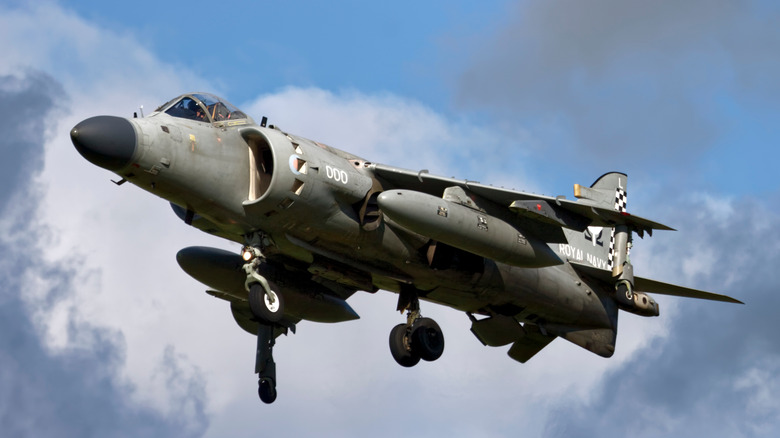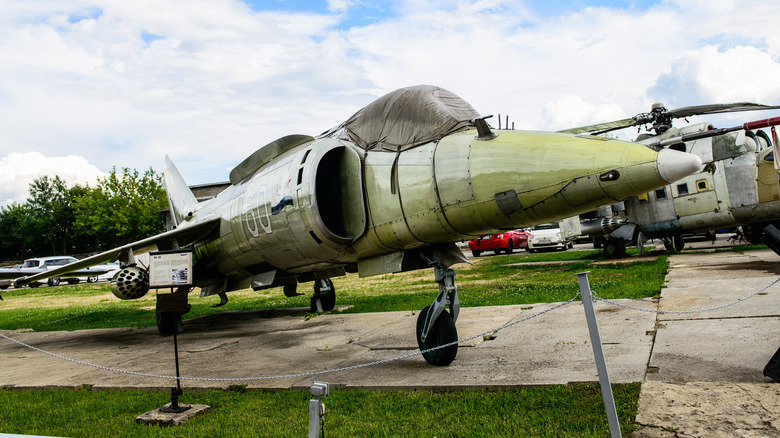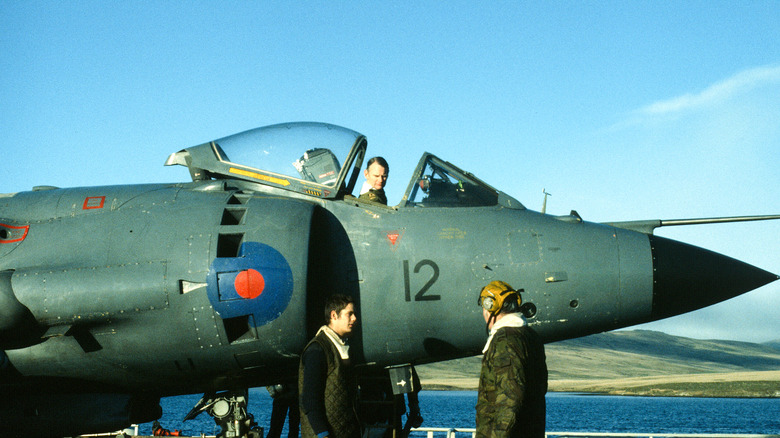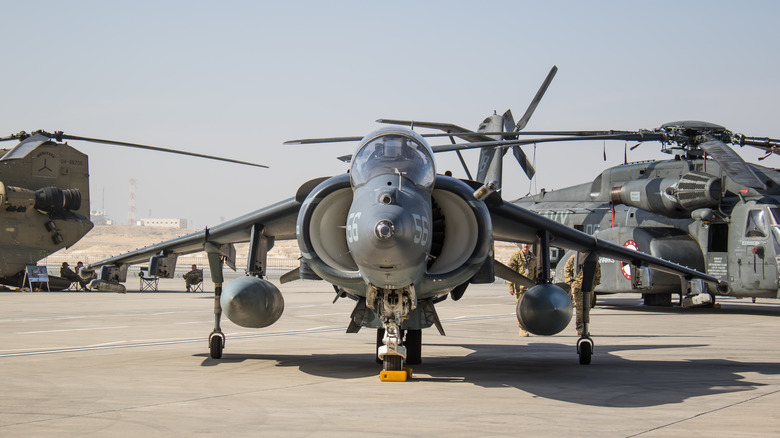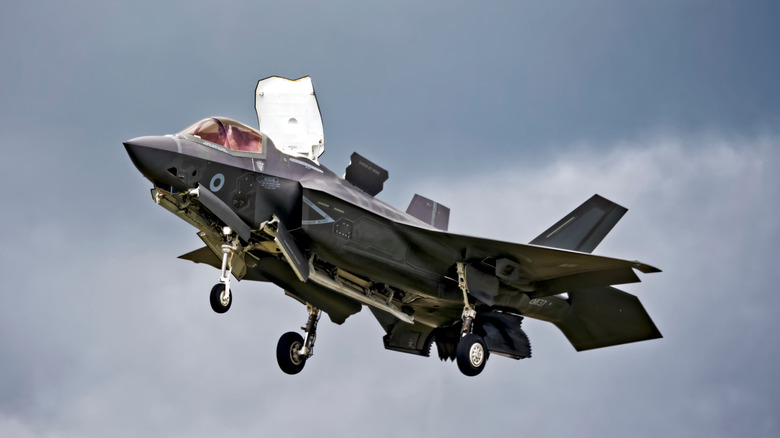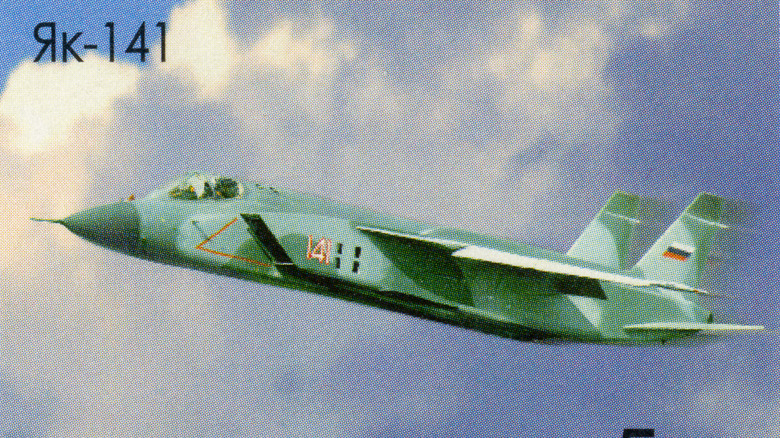Every VTOL Fighter Jet Ranked From Worst To Best
The first-ever powered flight was short. On December 17, 1903, Orville Wright took to the air in the plane he built with his brother Wilbur and covered 852 ft in 59 seconds before sinking back to Earth. It's amazing to consider that less than 66 years after that first successful attempt to beat gravity, NASA landed two human beings on the moon, after a journey of almost a quarter-million miles.
The development of powered aviation was incredibly rapid, helped by a couple of world wars. By the time Orville Wright died in 1948, rocket and jet-powered planes were already exceeding the speed of sound, and nimble, highly versatile helicopters were about to revolutionize military and medical transportation. But what if you could combine the convenience and versatility of a helicopter with the speed and power of a jet fighter?
The dream of transitional flight — from vertical hovering to conventional, horizontal high-speed flight and back again — was born in the middle of the 20th century, but it proved to be one of the toughest problems in aeronautical engineering. To this day, only a handful of vertical take-off and landing (VTOL) combat aircraft have ever been successfully developed, and only four models can claim to have been "operational." And even then, there are some caveats, as you'll see.
4: Yakovlev Yak-38
The Yakovlev Yak-38 was the only VTOL jet fighter ever to make it into the Soviet military's arsenal and the USSR's first operational carrier-based fixed-wing aircraft. Designed in the 1960s, the Yak-38 looked much like the British Harrier "jump-jet" (more on that in a minute) but was technologically quite different. Rather than the Harrier's elegant single engine and angled nozzles approach, the Yak-38 featured three engines. A main engine provided vectored horizontal and vertical thrust, and two smaller lift engines in the forward fuselage provided vertical thrust for VTOL flight.
The Yak-38 was originally intended to be supersonic but was ultimately rated for high subsonic flight only. Designed for fleet defense, the Yak-38 had a relatively small fuel capacity and limited combat radius, while its complex flight characteristics required a lot from its single pilot, especially on takeoff and landing. The forward fuselage lift engines also had a habit of ingesting exhaust gases, which sometimes caused them to lose power and shut down, so Yakovlev designed an automatic ejector seat that would propel the pilot to safety automatically in the event of engine failure or departure from controlled flight.
The Yak-38 scared NATO when it first appeared on Soviet ships in the late 1970s, but it was a relatively basic fighter with no radar, unsophisticated fire control, and limited capacity for weapons. Production totaled only around 230 airframes of all variants, and many were lost to accidents. While it gave Western nations a good fright and upgraded versions saw some combat service in the Russian Afghanistan campaign, the Yak-38 never represented a serious competitor to U.S. and U.K.-designed variants of the Harrier, either in capabilities or numbers.
3: British Aerospace Sea Harrier
The original "jump jet" was considered a technological marvel when the prototype first flew all the way back in 1960. Later versions of what became known as the Harrier differed greatly from that first prototype, but they all shared the same basic layout: a small airframe and short, stubby wings powered by a single powerful Pegasus engine, whose thrust could be vectored by moving nozzles, to allow vertical and horizontal flight.
The Sea Harrier was first deployed by the Royal Navy in 1978 and became arguably the definitive variant of the Harrier in British service. Compared to the ground-based "GR" variants, the Sea Harrier was designed specifically for use at sea and formed the cornerstone of U.K. fleet defense after the retirement of both the McDonnell Douglas F4 Phantom and Britain's large aircraft carriers in 1978. This decision looked disastrously short-sighted when in 1982, Argentina invaded the Falkland Islands, a remote British territory in the South Atlantic Ocean. Deployed in a hurriedly-assembled task force, the Harrier was left as the only British fighter aircraft capable of confronting the Argentine Air Force over the Islands. During the conflict, Harriers shot down 23 Argentine Air Force aircraft for no loss and supported the counterattack by British forces, which led to Argentina's surrender after 74 days of fighting. The Harrier's fame was secured.
The Sea Harrier was in use by the Royal Navy until 2006, during which time it was significantly updated. The ultimate Sea Harrier FA2 version, which featured a more powerful engine and upgraded weapons capabilities and avionics, was manufactured until 1998. The FA2 soldiered on in Indian Navy service until 2016, ending a remarkable 38-year front-line career.
2: McDonnell Douglas AV-8B Harrier II
It's easiest to think about the AV-8 and its variants as collectively the American Harriers, with the AV-8B as the definitive version. The AV-8B was the product of a U.S./U.K. collaboration to improve the performance of the first-generation Hawker Siddeley Harrier (known as the AV-8A in U.S. service). After the perennially cash-strapped U.K. dropped out of the program in the mid-'70s, McDonnell Douglas set about extensively redesigning the AV-8A. The resulting AV-8B retained the basic layout of the original Harrier models but included a brand-new, one-piece composite wing, a redesigned cockpit and fuselage, and an upgraded version of the Pegasus engine.
The first version of the AV-8B entered service with the U.S. Marine Corps in January 1985. Later versions included night attack capabilities and improved radar. Over the course of its career in U.S., Italian, and Spanish service, the AV-8B has seen extensive combat use, including intensive operation during both the first and second Gulf Wars, and NATO operations over Yugoslavia, Afghanistan, and Libya.
Throughout its long career in the USMC, the AV-8B has been blighted by a high accident rate, partly due to the amount of time spent in the dangerous vertical takeoff and landing phases of flight. In fact, the Harrier reportedly has an accident rate three times that of the USMC's F/A-18s. Despite the operational difficulties and the subsequent introduction of the more advanced F35B/C, the AV-8B is still in active service with the U.S., Italian, and Spanish militaries, almost 40 years after it was first introduced.
1: Lockheed Martin F35B/C Lightning II
The Lockheed Martin F35 Lightning II is a family of jets that includes two short take-off and vertical-landing (STOVL) variants, the F35B and F35C. While technically none of the F35 variants is capable of true VTOL operation, the STOVL variants can land vertically in certain conditions. That's good enough for us.
Famous for the massive cost of its development ($412 billion and counting), the F35 is a so-called "fifth-generation" fighter, with advanced avionics, stealth capabilities, and exceptional maneuverability, including the ability to take off and land using the congested decks of aircraft carriers. The reason that the F35 has cost so much to develop is that designing a cutting-edge "do everything" airframe that can accommodate the different needs of three distinct branches of the U.S. military, plus export partners, is extremely difficult. The STOVL F35B/C variants are especially complex, and feature a "lift fan" located in the forward fuselage, which acts together with the rear thrust-vectoring nozzle to support STOVL flight. The F35C also features a larger wing and larger control surfaces for better low-speed maneuverability.
As a combat aircraft, the F35 is formidable. A true "multirole" aircraft, the stealthy, supersonic F35 can handle both air superiority and strike requirements and is also capable of providing surveillance and electronic warfare capabilities. With most of the major teething troubles out of the way, the F35 now operates successfully in the inventories of the USAF, U.S. Navy, and the U.S. Marine Corps, and with allied air forces, including the British Royal Air Force and the Israeli Air Force. The only (officially confirmed) use of the F35 in combat was in 2018, by the Israeli Air Force.
Yakovlev Yak-141 and VFW VAK 191B (honorable mentions)
Not every VTOL fighter jet made it into operational service, and two models stand out as "what could have been?" examples of airplanes that never made it out of the prototype phase. Both the Yakovlev Yak-141 and VFW VAK 191B had a ton of potential but were doomed by money, politics, and the enduring difficulty of getting high-performance VTOL aircraft (literally) off the ground.
Remember the Yak-38 mentioned earlier? It was never meant to be the Soviet Union's only VTOL fighter. In fact, it was meant to be an interim model, to be succeeded by a more powerful supersonic fighter that became known as the Yak-141. The Yak-141 was designed for one job, and one job only: fleet defense. Substantially more powerful than the short-legged Yak-38, the Yak-141 had an afterburner that could power it to a speed of about Mach 1.7, and made extensive use of advanced materials, including titanium, in its construction. Production versions were to have boasted similar avionics to the famous Mig-29, including its helmet-mounted missile aiming system. Sadly (for Yakolev) the end of the Cold War put an end to development, and despite funding from U.S. manufacturer Lockheed for further development, only four prototypes were ever built.
The VFW VAK 191B didn't even get that far. Conceived in the 1960s as a home-grown fighter for the German Air Force, the VAK 191B was intended as a supersonic, VTOL nuclear weapons platform. Aside from deterrence, its main mission would have been counter-attack from dispersed locations in the event of war with the Warsaw Pact nations. Luckily that war never came, but neither did a production version of the VAK 191B
